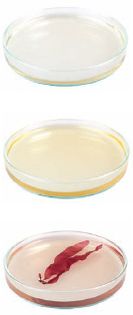Advertisement
The Art of Making Japanese Dashi
By Ole Mouritsen and Klavs Styrbæk
Published 2014

Three types of dashi, from top to bottom: konbu dashi, first dashi, and dashi made with the red alga dulse.
There are many ways of making dashi using a variety of ingredients, but they are all based on extracting glutamate from seaweed (konbu) to obtain basal umami. The outcome depends on the quality and freshness of the raw ingredients, as well as on the care taken in preparing the stock. Different cooks all have their own ideas about steeping time, water quality, temperature, and the shelf life of the stock. The traditional way of making dashi uses konbu and katsuobushi. Usually two extracts, first dashi (ichiban dashi) and second dashi (niban dashi), are made one after the other, reusing the ingredients. Only a portion of the glutamate in the seaweed is extracted into the dashi; the amount depends on the type of konbu, the hardness of the water, and the method used to make the stock. The recipes that follow also incorporate suggestions about alternative ingredients that you can use if you are not able to find konbu and katsuobushi or wish to make a purely vegetarian stock.

